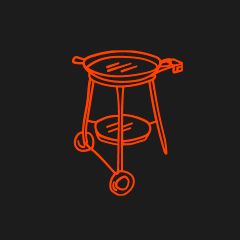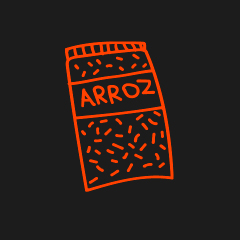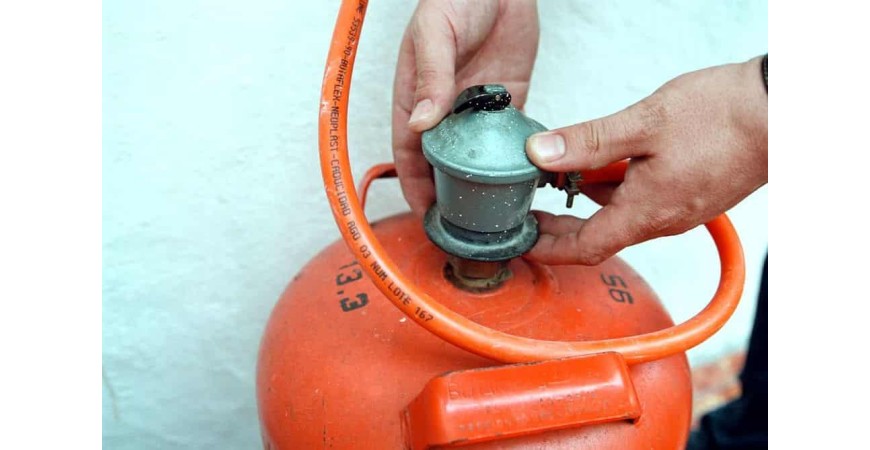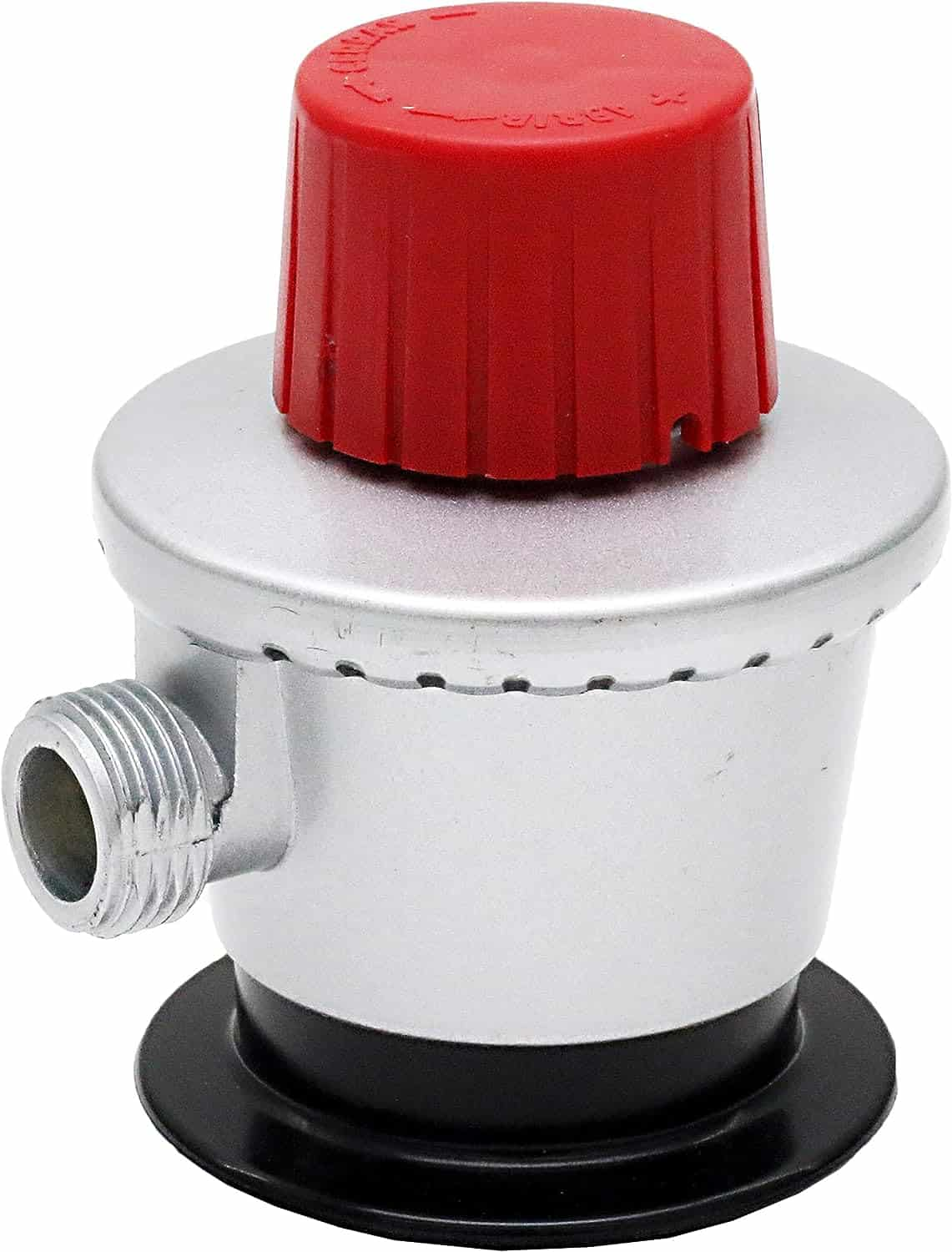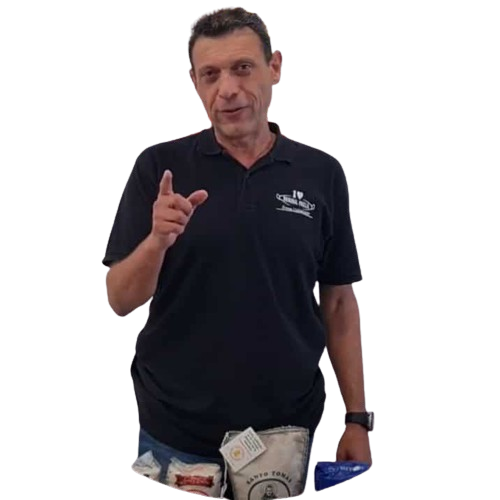What is the right gas regulator for my paella burner?
When you are looking for the right equipment to make paellas, it is common for many doubts to arise while you look at the different products you may need. Since what kind of paella pan would be the best for me, if I need a larger paella pan to make my paella well, or if I want a paddle or lid to cook as I like, the doubts pile up just like the possibilities of what product we want to take. to home.
If there is an essential accessory that perhaps not everyone gives the importance that we should, it would be the gas regulator for burner, also called gas showerhead, gas cape and a long list of synonyms. No matter how much equipment we have to make our paella, if we cannot light the fire on our burner to make it, our equipment is of no use to us.
This brings us to the main point of this blog post: What is the right gas regulator for my burner? First of all, it is advisable to warn about the incorrect use of our gas shower for paella pan, in order to take it into account when we look at the different gas regulators that exist.
What would be the appropriate gas regulator for my paella burner?
When we look at the different regulators, the biggest difference that we can find at first glance would be their power, measured in millibar.
The power of the regulator is important, as it dictates the outlet pressure of the gas that enters our burner and therefore the strength of the flame that it produces.
Due to the general butane/propane gas installations and how they are manufactured, the 30 mbar regulator is approved by law as the correct use for most of the occasions and devices that we can find in our daily lives.
This also applies to most of the burners and paella pans that we can find not only in our store, but in many others, because the burners are manufactured by standard to be used with this type of regulator, while paella pans that Use a regulator of 50 mbar or higher must be requested personally from the factory and are rarely found on store shelves or warehouses.
The best way to ensure that our paella burner has the correct burner cap is to choose the appropriate paella burner for that gas regulator and vice versa.
How to identify the operating pressure of a burner
Finding what gas pressure a regulator has is simple, but it is not so easy to find what operating gas pressure our burner requires.
Commonly, this information is within the product itself, either in its description and characteristics on the website, but we can also know it by looking at the label that we find on the control console of the paella burner.
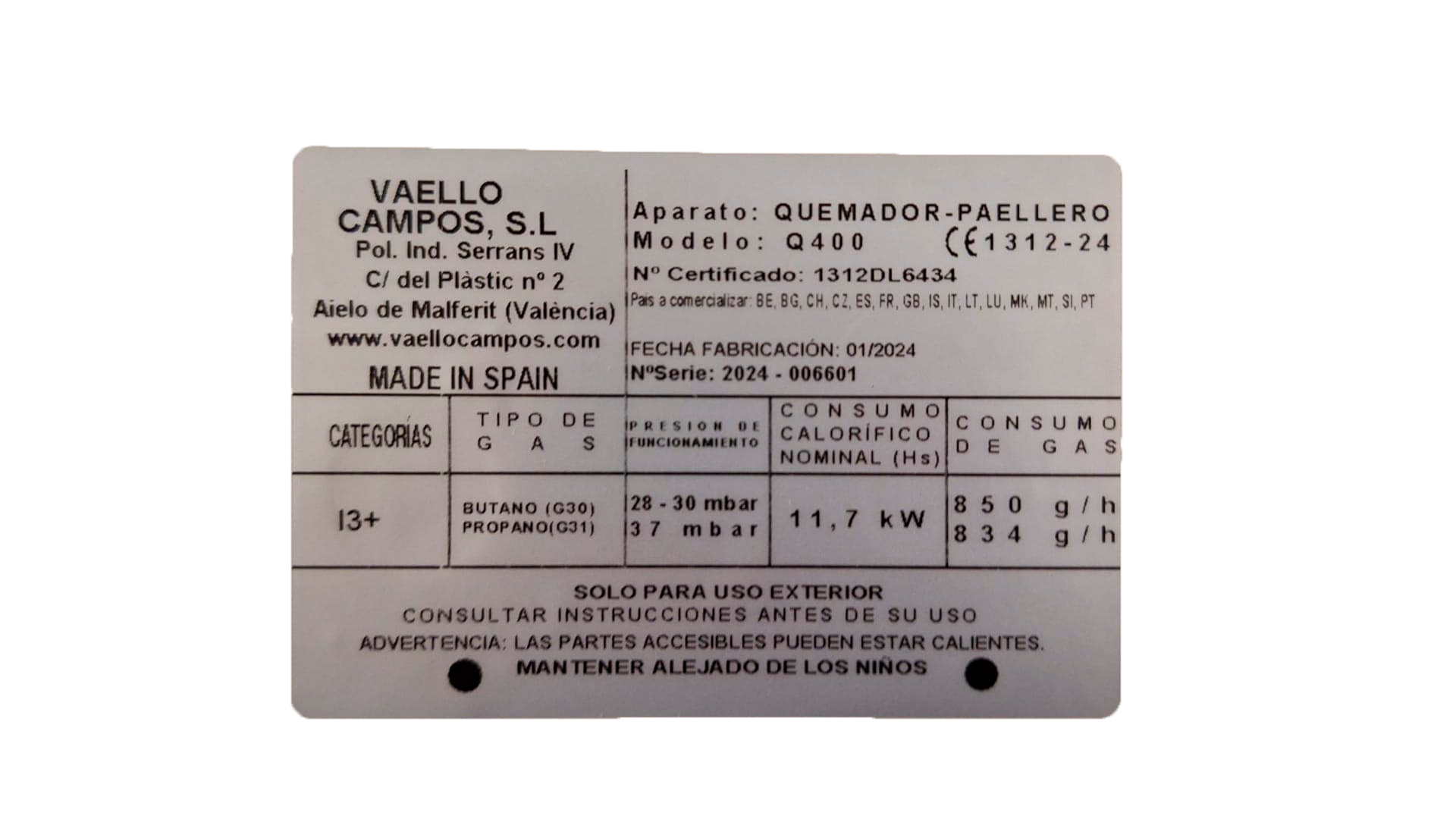
This is an example of said label, it not only tells us the type of gas that this burner accepts, it also informs us of the operating pressure and its heat and gas consumption. A quick look at this label on any paella pan can tell us everything we need to know how to choose the right regulator.
What happens if we use gas regulators with more power than indicated?
It should be noted that all gas burners have an oxygen inlet, normally this is located at the bottom of the controls and is visible by turning the burner around.
These air inlets are sized such that, at the approved gas pressure, they introduce the correct amount of oxygen for efficient combustion.
As the gas enters at a higher pressure than the approved one, the amount of oxygen that we will introduce through the air inlets will be less than that necessary for proper combustion of the gas, this will translate into a greater production of gases from combustion (CO and CO2 ) and a build-up of non-combustion gas resulting from a lack of the proper proportion of oxygen.
Types of gas regulators and their differences
Gas regulator 28/30 mbar (fixed pressure)
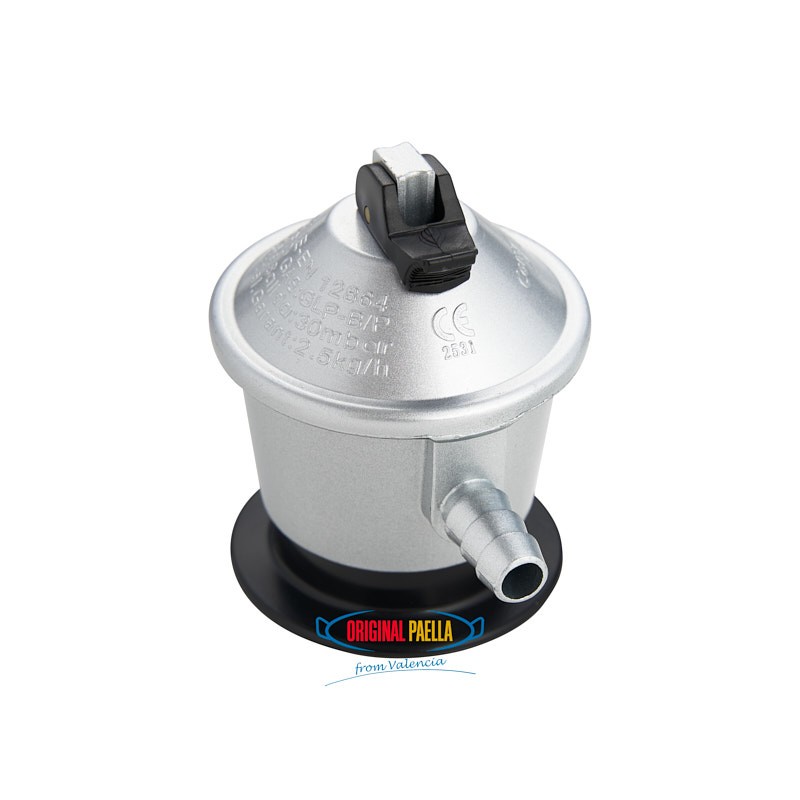
The 30 mbar gas regulator is the regulator for paella burner approved by law, as well as the standard in many other devices, silver in color, this regulator can be commonly found in the kitchens of any home. It has a gas output of 30 mbar, one of the most common.
This burner regulator, like its other brothers, has a simple connection, we only need to place its lower part on the cylinder and press against the valve, when we hear a click, we will know that the connection between both is well made. In the same way, if we want to disconnect it, we close the gas outlet and lift the cylinder regulator.
Keep in mind that we must do both actions with the regulator closed, to know if the gas outlet is closed we only need to look at the upper lever, if the lever is down, in the direction of the spout that allows the gas outlet, It means that it is closed, and it will be open if we move the lever in the opposite direction.
Gas regulator 50 mbar (fixed pressure)
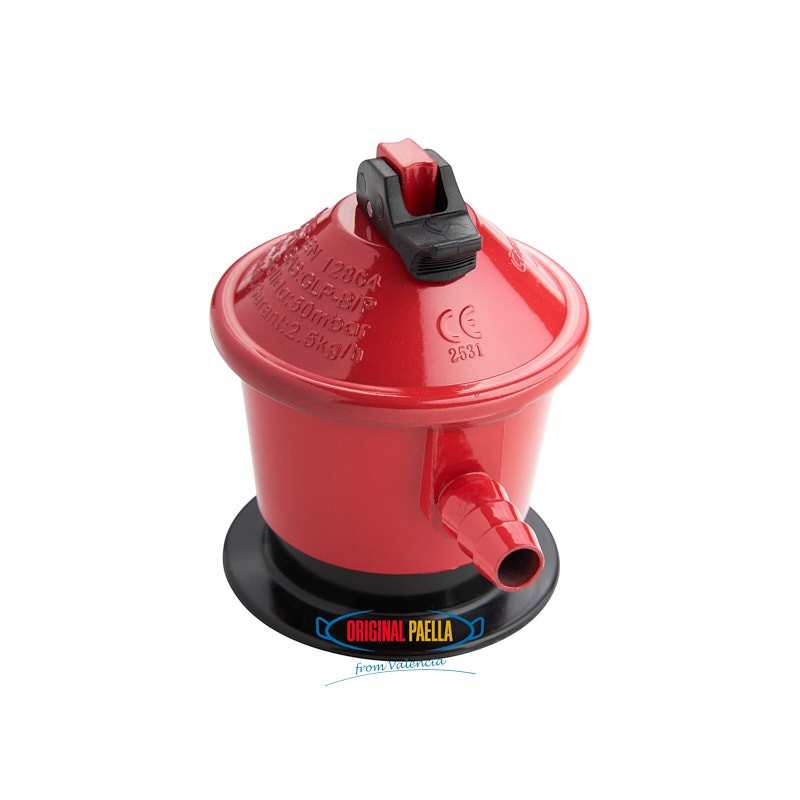
The 50 mbar gas regulator is the big brother of the 30 mbar gas regulator, red in color. This gas regulator is found in kitchens with large stoves or large burners.
The higher gas outlet pressure makes it perfect for cooking large volumes of food or many portions since this increase in pressure translates into an increase in power, although care must be taken to ensure that the appliance used is suitable for This higher gas outlet pressure can only be used legally in those burners that are factory approved at 50 mbar, since these are only manufactured to order.
Gas regulator 112 mbar (fixed pressure)
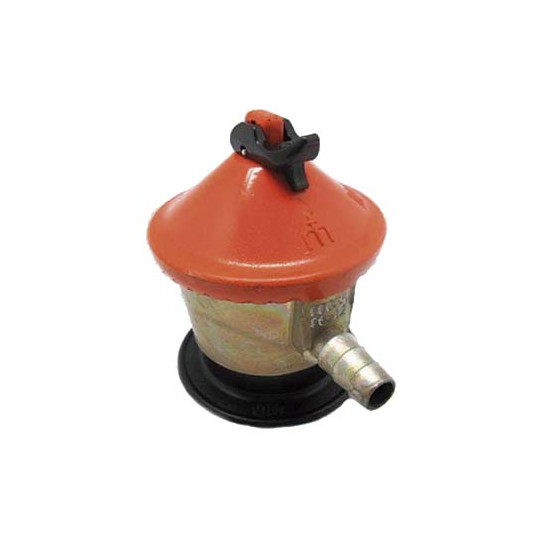
The gas regulator for the most demanding and powerful fires, recognizable by its orange top. It must be taken into account that no gas burner works in an approved manner at these gas pressures.
Characterized by letting out gas pressure at a fixed 112 mbar, it has a risk of use due to the accumulation of gas, in addition to carbon monoxide from incorrect combustion.
Free Exhaust Regulator or Variable Pressure Gas Regulator
Also referred to as an adjustable pressure gas regulator or pressure reducing regulator, it is a regulator capable of modifying its gas outlet pressure, they are suitable for use in appliances that operate with direct pressure, commonly found in professional kitchens. We know of this type of regulators of 2 variable pressure models: one has a pressure between 0 and 200 mbar and another between 0 and 2000 mbar.
Its use is very dangerous for several reasons, but mainly working at these pressures multiplies the manufacturer's recommendations by many times and that entails the risk of gas accumulation, carbon monoxide, as well as a great risk, potentially generating fires, accidents, deflagrations. ,etc.
Could I use a 50 mbar regulator on a 30 mbar paella pan?
After reading this blog post, you probably think that it is best to use the right regulator with the right paella burner, and you would be right.
We agree and can confirm that the power provided by these regulators is more than enough to prepare your paellas, but we know from experience with certain customers that not everyone thinks the same.
Using a 50 mbar regulator gives us a greater gas output and is a valid option for our burner as long as we use it for intermediate to large paella sizes, that is, from 50 cm in diameter to larger sizes, with a suitable paella pan.
Even so, as we have mentioned previously, the majority of burners that are manufactured and sold are for gas outputs of 30 mbar. Using a higher gas outlet pressure with a paella pan not suitable for those gas pressures can not only lead to the possibility of technical failures or possible accidents, it can also wear out the paella pan more quickly or eliminate the equipment warranty due to possible damage caused. through this gas outlet.
Therefore, we should take into account that the regulator is compatible with our paella burner. That we are able to use a regulator with higher gas pressure with a paella pan with lower gas pressure does not mean that it is what we have to do or what is most recommended.
What else might I need for my gas regulator?
.jpg)
Beyond your paella burner, you will need a flexible tube for butane and propane gas. These tubes have 2 clamps to connect to the ends of the tube, facilitating a better and safer connection with the devices we want to turn on. Commonly, you can find gas kits that come with the tube and the corresponding regulator.
Make sure that the rubber you use or buy is in perfect condition, cuts or holes can cause explosions or poisoning, in the same way, take into account the expiration date of the rubber, as well as if you observe deformations or wear, it is not worth it. It's worth taking the risk with this type of thing, better a new tire than having an accident.
Also keep in mind that you should not make joints of two or more rubber bands, if you need more than 1.5 meters of rubber you will require an approved installation.
If higher power is needed, we would require a 50 mbar propane/butane gas kit, more commonly used industrially.
If you want to see more content from our blog, follow this link.

